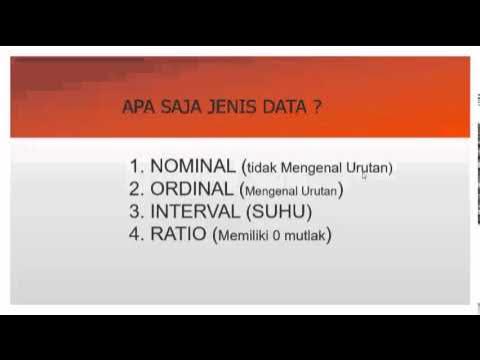CARA MEMBEDAKAN JENIS DATA NOMINAL, ORDINAL, INTERVAL, DAN RASIO | STATISTIKA PENELITIAN
Summary
TLDRThis video explains the different types of data used in statistical analysis, emphasizing the importance of understanding these categories for proper analysis. It introduces two main groups: categorical and numeric data. Categorical data includes nominal (exclusive categories) and ordinal (ranked categories), while numeric data is divided into discrete (countable values) and continuous (measurable values). The video further explores interval data, which has equal intervals but lacks an absolute zero, and ratio data, which has both equal intervals and an absolute zero, allowing for ratio comparisons. The presenter also provides practical examples and encourages viewers to engage with exercises to strengthen their understanding.
Takeaways
- 😀 Data can be divided into two main types: categorical and numeric.
- 😀 Categorical data includes nominal and ordinal data, while numeric data includes interval and ratio data.
- 😀 Nominal data represents categories without any inherent order, such as gender or school type.
- 😀 Ordinal data involves categories with a meaningful order but unequal distances between them, such as Likert scale ratings.
- 😀 Numeric data can be either discrete (countable, like the number of books) or continuous (measurable, like height or weight).
- 😀 Nominal data can be further divided into dichotomous (e.g., male vs female) and derived categories (e.g., rich vs poor based on income).
- 😀 Ordinal data can be subjective, as respondents might interpret categories like 'strongly disagree' differently depending on their perspective.
- 😀 Interval data has equal intervals between values, but no true zero point, such as IQ scores or temperature in Celsius or Fahrenheit.
- 😀 Standardized ordinal data can sometimes be treated as interval data if the instrument has been used repeatedly and is validated.
- 😀 Ratio data is similar to interval data but has an absolute zero point, making it possible to calculate ratios, such as weight or age.
- 😀 Understanding the different types of data is essential for selecting the correct statistical analysis method and ensuring accurate research results.
Q & A
What are the two main categories of data in statistics?
-The two main categories of data in statistics are categorical data and numerical data.
What is the difference between categorical data and numerical data?
-Categorical data refers to data that shows categories or characteristics (e.g., gender, type of school), while numerical data refers to data that can be measured quantitatively using numbers (e.g., height, weight).
What are the two types of categorical data?
-The two types of categorical data are nominal data and ordinal data.
What is nominal data?
-Nominal data refers to categories that are exclusive and represent distinct characteristics, such as gender (male or female) or school type (homeschooling or public schooling).
What is the purpose of coding nominal data in statistical analysis?
-Coding nominal data, such as assigning numbers to categories like '1' for male and '2' for female, helps in simplifying data entry and analysis in software like Excel or SPSS.
What is ordinal data, and how is it different from nominal data?
-Ordinal data represents categories that have a meaningful order or ranking but the intervals between them are not necessarily equal (e.g., Likert scales in surveys). Unlike nominal data, ordinal data has a ranking but does not guarantee equal distances between categories.
What is the difference between discrete and continuous numerical data?
-Discrete numerical data can be counted (e.g., number of books, chairs), while continuous numerical data can be measured and take any value within a range (e.g., height, weight).
What is interval data, and how does it differ from ordinal data?
-Interval data is numerical data where the intervals between values are equal, but it does not have an absolute zero (e.g., temperature in Celsius). Unlike ordinal data, interval data allows for mathematical operations like addition and subtraction.
How can ordinal data become interval data?
-Ordinal data can become interval data when it is standardized and used repeatedly, allowing for consistent and meaningful measurement. For example, standardized survey instruments can transform ordinal scales into interval data.
What is ratio data, and how does it differ from interval data?
-Ratio data is similar to interval data but includes an absolute zero, allowing for meaningful ratios between values. Examples include age, weight, and income. Unlike interval data, ratio data can be meaningfully divided (e.g., someone earning 200 dollars earns twice as much as someone earning 100 dollars).
Outlines

This section is available to paid users only. Please upgrade to access this part.
Upgrade NowMindmap

This section is available to paid users only. Please upgrade to access this part.
Upgrade NowKeywords

This section is available to paid users only. Please upgrade to access this part.
Upgrade NowHighlights

This section is available to paid users only. Please upgrade to access this part.
Upgrade NowTranscripts

This section is available to paid users only. Please upgrade to access this part.
Upgrade NowBrowse More Related Video

DEFINISI PENGOLAHAN DATA

Processed Data in IB Biology IA EXPLAINED by an IB Examiner | Part 9/12

Statistics: Basics – Epidemiology & Biostatistics | Lecturio

Manipulação de Dados em Python/Pandas - #02 Tipos de Variáveis

statistika dasar | pengantar statistik

SKALA PENGUKURAN KUISIONER : SKALA LIKERT, SKALA GUTTMAN, SEMANTIC DEFFERENSIAL, DAN RATING SCALE
5.0 / 5 (0 votes)